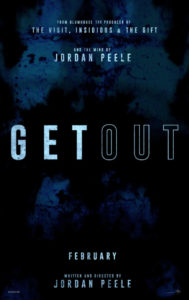*There are spoilers ahead*
“Finally, much of horror’s history has been about the removal of Blacks from the genre. Blacks have been rendered invisible by way of Whites in blackface, through a deprecation of Black culture without (and absent a contradictory response), or by way of wholesale exclusion. However, the substantive point to take away is that today “Black horror” is rather progressive, showering the genre with everything from intellectual exterminators, to (helpful) conjure women, to cannibal rappers. It has been said before, and it is worth saying again here … Black is back.”
—Robin R. Means Coleman, Horror Noire: Blacks in American Horror Films from the 1890s to the Present, 215.
 It is not mere happenstance that Get Out is flanked by two distinct images of black males that have become iconic within horror cinema. The opening scene showcases a young black man named Andre walking in an upper class suburban neighborhood where he is followed by a white sports car blaring “Run, Rabbit, Run”—an old WWII song by Flanagan and Allen—and is eventually accosted by the driver, suffocated and stuffed in the back of the car’s trunk perhaps to be dispatched.
It is not mere happenstance that Get Out is flanked by two distinct images of black males that have become iconic within horror cinema. The opening scene showcases a young black man named Andre walking in an upper class suburban neighborhood where he is followed by a white sports car blaring “Run, Rabbit, Run”—an old WWII song by Flanagan and Allen—and is eventually accosted by the driver, suffocated and stuffed in the back of the car’s trunk perhaps to be dispatched.
For those of us who live and breathe horror, the death of a black man at the hands of a masked killer is commonplace enough that it has become one of the most widely recognized horror tropes, at least since the 80s. However, it is seldom that type of horror would ever begin its narrative with a black man, but, instead, with an attractive, usually blonde and curvy young woman who is stalked and eventually killed by the hand of our faceless villain. Within five minutes of Get Out, we are already seeing a collision between expectations of and deviations from white horror narratives. This interplay of expectation, appropriation and subversion of horror canon becomes the backbone of Get Out’s profound and groundbreaking dissection of racism in modern day America.
Jordan Peele—who is most well known for being one-half of the comedy duo Key & Peele—takes the audience on a blistering social nightmare as we follow another young black man, Chris (Daniel Kaluuya), and his white girlfriend, Rose (Allison Williams) as they embark on a trip to meet her rich, seemingly progressive parents, the Armitages, at their expansive rural home. A place where probably no one could hear you scream.
Get Out seems familiar in its setup because it is utilizing rather typical horror elements: faceless killers, isolated home, people that are acting less than human, unnerving parents, etc. Peele, however, lays this foundation because what Get Out ends up doing is appropriating white horror narratives and tropes—a tactic white people have done to black culture for centuries—to express the inherent fears of the black experience in modern American society. The result is the repeated clarion call of Robin R. Means Coleman: black people refuse to be made invisible any longer.
 The influences run deep in the film. Everything from the blackface of early silent films like Griffith’s The Birth of a Nation to The Invasion of the Body Snatchers to the various slasher knockoffs of Halloween and Friday the 13th as well as Blaxploitation horror is harkened back to by way of trope, framed shot or narrative conceit. Peele spoke specifically on NPR’s Code Switch of two Ira Levin-penned novels adapted for the screen, The Stepford Wives (1975) and Rosemary’s Baby (1968), as central influences behind the script and his direction of Get Out. It is no surprise then this film trades in the imagery of claustrophobic spaces, cult-like conspiracies, increasingly alien forms of human behavior and parasitic conformity.
The influences run deep in the film. Everything from the blackface of early silent films like Griffith’s The Birth of a Nation to The Invasion of the Body Snatchers to the various slasher knockoffs of Halloween and Friday the 13th as well as Blaxploitation horror is harkened back to by way of trope, framed shot or narrative conceit. Peele spoke specifically on NPR’s Code Switch of two Ira Levin-penned novels adapted for the screen, The Stepford Wives (1975) and Rosemary’s Baby (1968), as central influences behind the script and his direction of Get Out. It is no surprise then this film trades in the imagery of claustrophobic spaces, cult-like conspiracies, increasingly alien forms of human behavior and parasitic conformity.
Two of the clearest call backs though within Get Out come from the sci-fi horror of the 50s and 70s; specifically, The Invasion of the Body Snatchers (1956) and The Stepford Wives (1975) where the central character starts noticing a slow homogenizing of the their surrounding population. In Invasion, people are replicated perfectly in form by alien pods, but these duplicates are devoid of all emotion. While in Stepford Wives, it is the women of a small community that become docile and mindless housewives, all acting peculiarly servile in their gender roles.
Both films found their horror within specific time periods. Invasion was dealing with the double-blind fear of Communism and its equally harrowing counterpart, McCarthyism, while Stepford was operating within the fears of a patriarchal society responding to feminism and the movement of women away from traditional gender roles. However, these films found the expression of their fear within a white context devoid of little, if any, minority presence.
 Peele appropriated these white narratives to speak to the very real danger that is felt by black people in our current American climate: live within the homogeneity of a culture dictated by whiteness or be discounted physically, socially and/or economically. Peele lays out his cinematic case by literally translating onto the screen the continuing implications of the earliest portrayals of black people in cinema: white people in black face. Instead of just using black shoe polish, the Armitages have created a scientific transplantation named “Coagula” where a white person’s brain is placed inside of a black person’s body.
Peele appropriated these white narratives to speak to the very real danger that is felt by black people in our current American climate: live within the homogeneity of a culture dictated by whiteness or be discounted physically, socially and/or economically. Peele lays out his cinematic case by literally translating onto the screen the continuing implications of the earliest portrayals of black people in cinema: white people in black face. Instead of just using black shoe polish, the Armitages have created a scientific transplantation named “Coagula” where a white person’s brain is placed inside of a black person’s body.
The rich, white attendees of “The Gathering” bid on Chris’ black body and talents (unbeknownst to him at the time) mimicking the slave markets of the American South. The bidders are able to exclaim the superiority of blackness in many forms while still wanting to tame black people who they still consider to be animals or monsters, an idea that, according to Coleman, has infected cinematic images of blackness from The Birth of a Nation to The Creature from the Black Lagoon, and beyond.
The “superior” white mind then becomes the key to appropriating blackness within a homogenous white culture. So, as Chris navigates the racially coded language of those attending “The Gathering,” we begin to see how even the most subtle use of language plays into the overarching system of racism and privilege inherent in white culture, regardless of how progressive the white people identify as—for the Armitages are self-proclaimed progressive Democrats. Peele is able to take the framework of white fears within Invasion and Stepford and invert it to navigate the complexities of blackness and the struggles of maintaining a distinct black identity within an increasingly aggressive white-saturated and -privileged society.
Chris is then sold to a blind art-dealer who wants his physical eyes and his artistic vision. He is hypnotized and held captive in the Armitages’ basement while he goes through psychological torture in order to prepare his mind for the transplant. The final fifteen minutes of the film become a brutal struggle to escape before he, too, becomes another “homogenized” black person like those he had met during the weekend, including Andre.
 It is in the final scene of Get Out that we get the second iconic horror image of a black man. Chris is straddling a white woman, choking her, on a road after escaping from the Armitage residence. In that moment, the familiar “whoop!” of a police siren is heard and, within the cultural milieu of our times, the pits of our stomachs fall out because we know how these interactions usually end.
It is in the final scene of Get Out that we get the second iconic horror image of a black man. Chris is straddling a white woman, choking her, on a road after escaping from the Armitage residence. In that moment, the familiar “whoop!” of a police siren is heard and, within the cultural milieu of our times, the pits of our stomachs fall out because we know how these interactions usually end.
For horror fans, however, this interaction should be quite familiar as well if we think back to one of the only examples of a strong, self-possessed black man in a horror film, Ben from 1968’s Night of the Living Dead. Ben is a black man trapped in a house with all white people—men, women and children—and remains the only character who does not become hysterical as the house becomes besieged by the living dead. Ben, played by Duane Jones, is an iconic and striking figure within the horror canon and, yet, we also know his fate. He makes it through the night, surviving the zombies, outside, and racism given flesh, inside, only to be, as Coleman states, “shot dead by his ‘natural enemies, Pittsburgh cops and rednecks.'” His death and the subsequent stills showing the disposal of his body “look like they could be the weathered photos of Emmett Till…[Ben’s] lifeless corpse being impaled by meat hooks and lifted for transport to a pyre. Ben’s body is then pressed down into the fire by wood and other debris. In the end, ‘our hero is not only dead but obliterated. There will be no record of his struggle, no burial or memorial, no hope of justice'” (107-108).
Peele is not seeking to pattern Get Out within the same futility as Night of the Living Dead, but wants to inculcate the same dread and terror within that moment, fully recognizing the backdrop of the recent onslaught of black men and women being shot by white policemen in America. Ben’s death was a memorable moment within horror history and one that has echoed beyond the silver screen far, far too often in the last few years. So when the sirens go off and the lights of the police car hit Chris, that is the full expectation. And, yet, on the other side of the car’s lights we find Rod, his best friend and a TSA agent, who has come after him. Peele takes an iconic horror scenario and, once again, turns it on its head. On the other side of the uniform is his friend, another black man, who has come to deliver him from this nightmare.
 As jarring as Night of the Living Dead was by featuring a strong black man as its lead at the time, white people still came out on top in the end by killing him and preserving their whiteness—which feels realistic within the cultural space our society inhabits right now. But Peele, instead, offers a complicated word of hope as Get Out’s final statement: black people will overcome and they will maintain their unique voice and identity apart from white contexts and structures. Unfortunately, this conclusion will not be had, it appears, with the help of white people unless they topple the idolatry of their own whiteness and humble themselves with the knowledge of their own privilege. It seems that Peele’s assertion in Get Out is dependent on the strength of the black community to accomplish this feat within our modern American society.
As jarring as Night of the Living Dead was by featuring a strong black man as its lead at the time, white people still came out on top in the end by killing him and preserving their whiteness—which feels realistic within the cultural space our society inhabits right now. But Peele, instead, offers a complicated word of hope as Get Out’s final statement: black people will overcome and they will maintain their unique voice and identity apart from white contexts and structures. Unfortunately, this conclusion will not be had, it appears, with the help of white people unless they topple the idolatry of their own whiteness and humble themselves with the knowledge of their own privilege. It seems that Peele’s assertion in Get Out is dependent on the strength of the black community to accomplish this feat within our modern American society.
Get Out remains an exciting addition to the horror (and film) canon. A film that I, personally, came out of the theater thinking I had witnessed a film that would echo into the future of horror cinema much like Halloween did in the late 1970s. I can only hope that the trend from Get Out, on, seeks further exploration of the nightmares of those on the outside of the margins of whiteness, masculinity and heterosexuality, so that we all may be able to see their fears and recognize our own part in their creation.
Massive thanks to Antonio “Eons D” Gardner and Zachary Sinclair Nunn for reading and giving me feedback on this piece.



1 comment